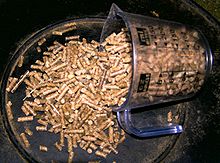- Compound feed
-
Compound feeds are feedstuffs that are blended from various raw materials and additives. These blends are formulated according to the specific requirements of the target animal. They are manufactured by feed compounders as meal type, pellets or crumbles.
Compound feeds can be complete feeds that provide all the daily required nutrients, concentrates that provide a part of the ration (protein, energy) or supplements that only provide additional micronutrients, such as minerals and vitamins.
According to the American Feed Industry Association, as much as $20 billion worth of feed ingredients are purchased each year. These products range from grain mixes to orange rinds to beet pulps. The feed industry is one of the most competitive businesses in the agricultural sector, and is by far the largest purchaser of U.S. corn, feed grains, and soybean meal. Tens of thousands of farmers with feed mills on their own farms are able to compete with huge conglomerates with national distribution. Feed crops generated $23.2 billion in cash receipts on U.S. farms in 2001. At the same time, farmers spent a total of $24.5 billion on feed that year.
Around 600 million tons of feed are produced annually around the world.
Contents
History
The beginning of industrial scale production of animal feeds can be traced back to the late 19th century; this is around the time that advances in human and animal nutrition were able to identify the benefits of a balanced diet, and the importance of the role that the processing of certain raw materials played. Corn gluten feed was first manufactured in 1882, while leading world feed producer Purina feeds was established in 1894 by William H. Danforth. Cargill, which was mainly dealing in grains from its beginnings in 1865, started to deal in feed at about 1884.
The feed industry expanded rapidly in the first quarter of the 20th century, with "Purina" expanding its operations into Canada, and opened its first feed mill in 1927 (which is still in operation).
In 1928, the feed industry was revolutionized by the introduction of the first pelleted feeds - Purina Checkers.
Ingredients
The main ingredients used in commercially prepared feed are the feed grains, which include corn, soybeans, sorghum, oats, and barley. Corn production was valued at nearly $25 billion in 2003, while soybean production was valued at $17.5 billion. Roughly 66 percent of sorghum production, which was valued at $965 million in 2003, is used as livestock feed. Approximately 60 percent of barley production, which totaled 227 million bushels (4,610,000 metric tons) and was valued at $765 million in 2003, is used as livestock feed. Annual oat production in 2003 was valued at $218 million.
The sale and manufacture of premixes is an industry within an industry. Premixes are composed of microingredients such as vitamins, minerals, chemical preservatives, antibiotics, fermentation products, and other essential ingredients that are purchased from premix companies, usually in sacked form, for blending into commercial rations. Because of the availability of these products, a farmer who uses his own grain can formulate his own rations and be assured his animals are getting the recommended levels of minerals and vitamins.
Manufacture
The job of the feed manufacturer is to buy the commodities and blend them in the feed mill according to the specifications outlined by the nutritionist. There is little room for error because, if the ration is not apportioned correctly, lowered animal production and diminished outward appearance can occur.
Industry leaders
Globally
The world's largest feed manufacturer is the CP Group Thailand, producing 18 million tonnes of compound feed at various locations across East Asia.
Europe
The merge of the Hamburg-based traditional commodity trade firm, Cremer, and the Düsseldorf based Deuka (Deutsche Kraftfutterwerke), led to one of the largest feed companies in Europe. The new Cremer Group produces around 3.5 million tons.
United States
Leading U.S. companies involved in prepared feeds production in the early first decade of the 21st century included ConAgra Inc., an Omaha, Nebraska-based firm; and Cargill, Incorporated, a diversified company that was the nation's top exporter of grain. In 1998, Ralston Purina Company, based in St. Louis, Missouri, formed Agribrands International, Inc. to control its international animal feed and agricultural products division. Agribrands produced feed and other products for livestock in markets outside of the United States, and had about 75 facilities operating in 16 countries. In 2001, it was acquired by Cargill.
Other significant industry players included Conti Group Companies, Inc., the world's leading cattle feeder; CHS, Inc. (previously known as Cenex Harvest States Cooperative), which was primarily involved in grain trading; and Farmland Industries, Inc., the leading agricultural cooperative in the United States. Farmland was a worldwide exporter of products, such as grain. In May 2002, the firm declared bankruptcy, and in the following year, Smithfield Foods acquired most of Farmland's assets.
See also
External links
Categories:
Wikimedia Foundation. 2010.

